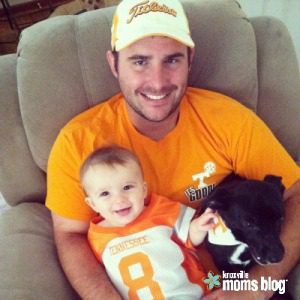 My husband and I are what you would call “dog people.” We both had dogs growing up and we knew we wanted our children to experience life with pets. Shortly after we got married we adopted our first dog (Sandler) from Young Williams Animal Shelter. A few months later we decided he needed a companion so we added a new furry friend (Peyton) from the Humane Society. When I became pregnant, I was very apprehensive about how our dogs would react to the new baby. Up until Jake came into our lives, our two dogs were our only babies. To say they are spoiled is an understatement. We were particularly worried about Peyton and so I gathered as much information as I could and came up with a game plan.
My husband and I are what you would call “dog people.” We both had dogs growing up and we knew we wanted our children to experience life with pets. Shortly after we got married we adopted our first dog (Sandler) from Young Williams Animal Shelter. A few months later we decided he needed a companion so we added a new furry friend (Peyton) from the Humane Society. When I became pregnant, I was very apprehensive about how our dogs would react to the new baby. Up until Jake came into our lives, our two dogs were our only babies. To say they are spoiled is an understatement. We were particularly worried about Peyton and so I gathered as much information as I could and came up with a game plan.

1. Know your dog
Our dogs have VERY opposite personalities. Sandler has been with us since he was about 8 weeks old so he is very comfortable around us and around kids. Jake can tug on his ears, try to eat his tail, or chase him around the living room and Sandler just plays along. Peyton on the other hand is a completely different story. Peyton was rescued from a puppy mill when he was about 2-3 years old. He has an extremely abusive past and really struggled with fear-based aggression for the first few weeks after we brought him home. He has since warmed up to us but is still very timid around strangers and especially children. His fear is usually manifested in aggression. Before we brought Jake home from the hospital, we knew that Peyton would take more work to warm up to this new little human in our house. It is important to know what kind of personalities you are working with before you bring baby home and it is important to know how your dogs react around other children.
2. Start early
This may sound silly, but we actually borrowed one of those life-like crying babies you take home in high school (my mom is a high school child development teacher) and integrated the doll into our daily activities for a few weeks before I had Jake. We would rock the doll, sit the doll in various spots around the house, and activate the crying noises. At first both dogs were very confused but I definitely think it helped them get accustomed to something other than them taking up our attention. Having Fake Jake also allowed us to begin setting boundaries and limits with the dogs such as not licking him (don’t ask me if we were successful with that one), no jumping on him, etc. While we were in the hospital, I also had my parents bring home one of Jake’s blankets so that the dogs could sniff it and become familiar with Jake’s scent.
3. Take cues from your dog
Your dog will definitely let you know if she/he is uncomfortable. Don’t try to force the dog to interact with the baby. Watch for body language such as avoidance, cowering, or more obvious forms of fear like bearing teeth.
4. Look for learning opportunities – with your human baby AND your furry baby
Over the past few months, as Jake has become more mobile, I have begun to “train” him on appropriate interactions with the dogs. For example, when Jake yanks on Sandler’s ear I will correct him and show him how we correctly pet a dog. I have also noticed Peyton becoming increasingly curious about Jake – which is a HUGE step forward! He will approach Jake to sniff him and is very curious about his toys. Peyton is still quick enough to outrun Jake but I know as Jake gets older (and faster) he will eventually be able to catch up to him. This is where the “human training” becomes very important. Teaching kids to respect animals and be cognizant of their space is vital. I wouldn’t want someone biting me or slapping me in the face and chances are your dog won’t like that either.
5. Be patient
Your dog(s) may take a while to be accustomed to the new addition. Jake is almost 9 months old and Peyton still cowers and runs from him 90% of the time. It is a learning process for all of us. Your dog(s) may not every be 100% comfortable around small children and babies and that is okay too. Just make sure to watch carefully for signs of strong aggression.
6. Seek professional help
Obviously I am not a dog trainer. All of my anecdotal advice is purely from my experience. Every dog is so different and some may need a little extra help overcoming the jolt in life when a new baby is brought home. There are several places in Knoxville that offer dog training and you can also use your veterinarian as a resource. We took Sandler to a training class at PetSmart when he was younger which helped a ton with him learning his basic cues and helped us establish dominance as the pack leader (any Dog Whisperer fans out there?).
For more information, read this awesome and comprehensive article written by the ASPCA.

Do you have any tips for introducing your new baby to your dogs? We would love to hear them!




















